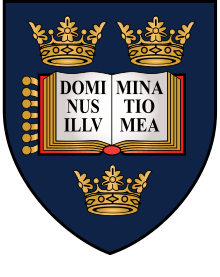Blackfriars, Oxford
| Colleges and halls of the University of Oxford Blackfriars Hall | ||||||||||||
| | ||||||||||||
|
| ||||||||||||
| College name | Blackfriars Hall | |||||||||||
| Latin name | Aula Fratrum Praedicatorum | |||||||||||
| Named after | The black cappa of the Dominican Friars | |||||||||||
| Established | 1221 (re-established as religious house, 1921; as a hall, 1994) | |||||||||||
| Sister college | None | |||||||||||
| Regent | Simon Gaine | |||||||||||
| Undergraduates | 8 | |||||||||||
| Graduates | 21 | |||||||||||
| Location | St Giles', Oxford | |||||||||||

| ||||||||||||
| Homepage | ||||||||||||
 | ||||||||||||
| Blazon | Gyronny sable and argent, a cross flory counterchanged. | |||||||||||
Blackfriars, Oxford is a Permanent Private Hall of the University of Oxford. Blackfriars houses three distinct institutions: the Priory of the Holy Spirit, the religious house of the friars, whose current prior is Very Rev Dr Martin Ganeri OP; Blackfriars Studium, the centre of theological studies of the English Province of the Dominican Friars (although it numbers members of other orders and lay people among its students and lecturers); and Blackfriars Hall, one of the constituent educational institutions of the University of Oxford. The current Regent of both the Hall and Studium is Very Rev Dr Simon Gaine OP. The name "Blackfriars" is commonly used to denote a house of the Dominican Friars in England, a reference to the black-colored "cappa", which is part of their habit.
Blackfriars Hall is a Permanent Private Hall, meaning that it is owned and governed by an outside institution (in this case, the English Province of the Order of Preachers) and not by its fellows.
Located in central Oxford on St Giles', its neighbours include St John's College, Oxford, St Cross College, Oxford and the Ashmolean Museum. Blackfriars Hall is a centre for the study of theology and philosophy informed by the intellectual tradition of St Thomas Aquinas. It admits men and women of any faith for Oxford undergraduate degrees in theology schools, PPE and for a wide range of postgraduate degrees.
History

Blackfriars' history is well documented, largely as a result of the hall being part of an international fraternity of scholarship, which was able to monitor and document its fortunes, even during times of the hall's collapse.
The Dominicans arrived in Oxford on 15 August 1221, at the instruction of Saint Dominic himself, little more than a week after the friar's death. As such, the hall is heir to the oldest tradition of teaching in Oxford, a tradition that precedes both the aularian houses that would characterise the next century and the collegiate houses that would characterise the rest of the University of Oxford's history.
Like all the monastic houses in Oxford, Blackfriars came into rapid and repeated conflict with the University authorities. With the Reformation, all monastic houses, including Blackfriars, were suppressed. The Dominicans did not return to Oxford for some 400 years, until 1921 when Blackfriars was refounded as a religious house, within 600 metres of the original site. The Dominican Studium at Blackfriars had a close relationship with the University, culminating in the establishment of Blackfriars as a permanent private hall in 1994.
Institutes
Blackfriars Hall is the home of a number of other institutes including, the Las Casas Institute on ethics, governance and social justice.[1] Launched in November 2008, the institute contributes to the hall's founding vision to be a centre of the social as well as the sacred sciences.[2] Its founding director (from October 2008 to January 2011) was Francis Davis.[3] The second director of the institute is Michael Oborne, formerly Director of Futures at the OECD.
The International Young Leaders Network exists to identify young leaders aged 18 to 33 from the Christian community globally.[4]
The Aquinas Institute was established in 2004 under the directorship of Fergus Kerr.[5] It aims to foster study of St Thomas at Oxford through seminars, conferences, summer schools and programmes. Patrons of the institute include John Haldane, Alasdair MacIntyre, Ralph McInerny and Eleonore Stump.
Academic programmes
Blackfriars offers those preparing for the Catholic priesthood the Baccalaureate in Sacred Theology (STB) granted by the Pontifical University of Saint Thomas Aquinas, Angelicum in Rome. It is also possible for lay men and women to begin the Angelicum's STB programme by studying in the Blackfriars Studium and to conclude the programme with at least a year's full-time study at the Angelicum.
Blackfriars' Studium offers one or two year programs in Catholic Theology which lead to an Oxford University Certificate or Diploma in Pastoral Theology.[6]
People associated with Blackfriars
Notable former students
- Anthony Fisher OP 9th Roman Catholic Archbishop of Sydney
- James Alison, theologian and author
- Delia Gallagher, journalist, CNN Faith and Values Correspondent
- Herbert McCabe, theologian and philosopher
- Malcolm McMahon, Archbishop of Liverpool
- Aidan Nichols, first John Paul II Memorial Visiting Lecturer at the University of Oxford
Fellows and academics
- John Battle - former MP for Leeds West
- Brian Davies - philosopher and former Regent
- Richard Finn - former Regent and Novice Master for The English Province of The Order of Preachers
- Andrew Linzey - theologian, author, and prominent figure in the Christian vegetarian movement
- Timothy Radcliffe - Master of the Order of Preachers from 1992–2001
- Fergus Kerr - Regent (1998-2004)
- James MacMillan - classical composer and conductor, Honorary Fellow
- John Saward - fellow of Greyfriars and associate lecturer at Blackfriars
- Roger Scruton - philosopher who specialises in aesthetics
References
- ↑ "Blackfriars - Hall - Las Casas Institute". Bfriars.ox.ac.uk. Retrieved 5 October 2014.
- ↑ "New Las Casas Institute launched at Blackfriars Hall". Ox.ac.uk. Retrieved 5 October 2014.
- ↑ "Las Casas director appointed government advisor". Ox.ac.uk. Retrieved 5 October 2014.
- ↑ Archived November 14, 2012 at the Wayback Machine
- ↑ "Blackfriars - Hall - Aquinas Institute". Bfriars.ox.ac.uk. Retrieved 5 October 2014.
- ↑ Archived October 7, 2014 at the Wayback Machine
